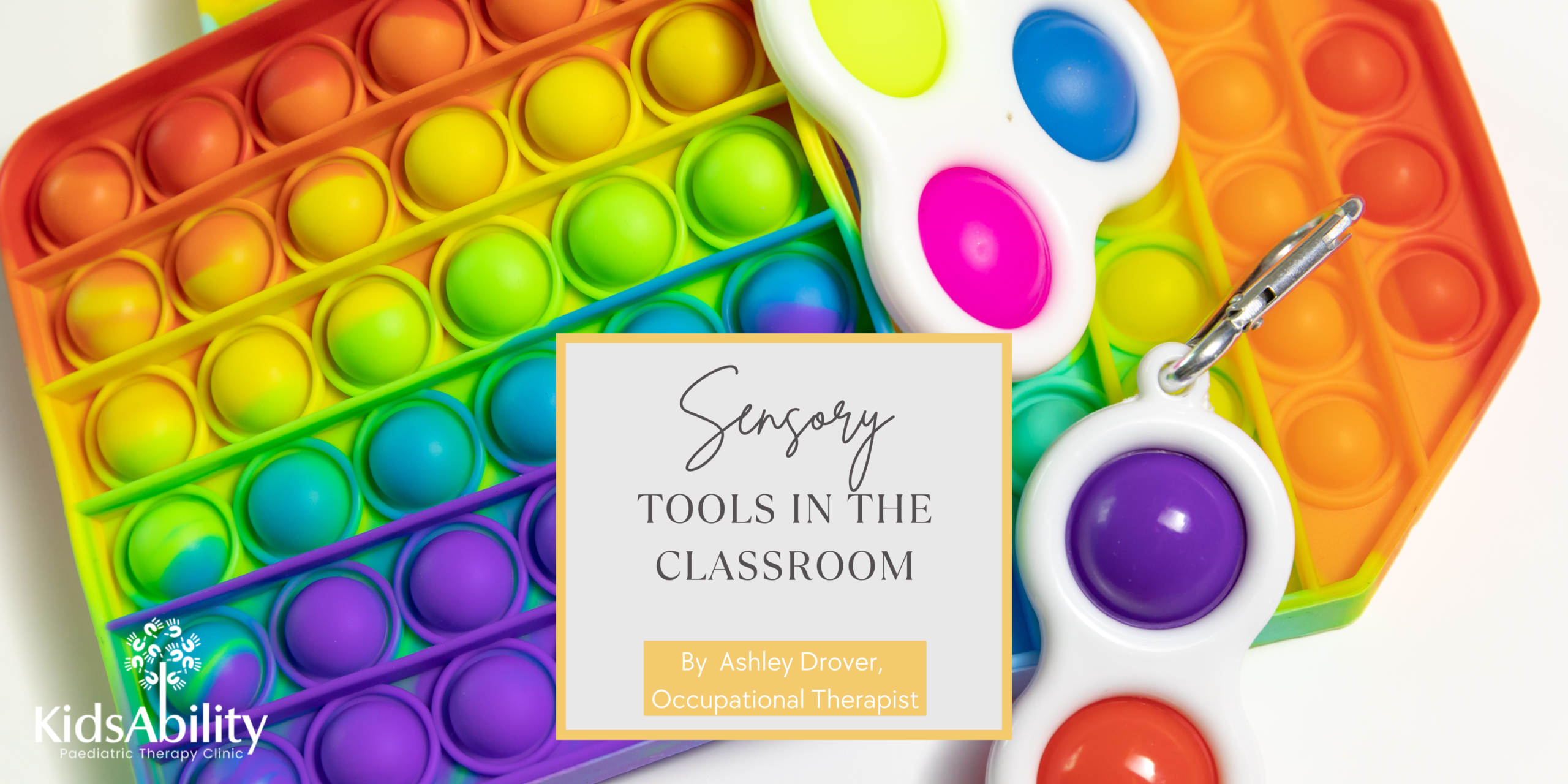SENSORY TOOLS FOR THE CLASSROOM: By Ashley Drover, Occupational Therapist

Sensory tools can be found in most schools, with students being offered wobble cushions, balance balls, or fidget spinners to help them ‘pay attention’. However, when a child is in need of sensory tools, these should rarely be used in isolation and instead be used as part of a tailored and customized treatment plan. Sensory Integration Therapy, developed by Jean Ayres, has been found to be an evidence based practice and effective when provided by a trained therapist (Schaaf et al. 2014). However, many of the tools that are recommended from trained therapists, such as weighted vests, fidget toys, or sensory rooms have little evidence when used solely in isolation (Smith et. al 2014).
As the American Occupational Therapy Association supported in 2018, ‘practitioners should use Sensory Integrative Therapy using clinical reasoning, existing evidence, and outcomes to create a comprehensive and individualized approach for each client, rather than using isolated, specific sensory strategies’. Therefore, it is unlikely that one sensory tool will fit all, and that it will provide a child with all the sensory input they are needing. This is not to say that sensory tools in the classroom are not to be used, but instead, that if we are seeing a child seeking or benefiting from such a tool, there are likely other components which could be investigated to create an individualized plan for the child.
As occupational therapists, our recommendations are specific to each child, and is often referred to as a ‘sensory diet’. A sensory diet is based on the idea that controlling sensory input can affect one’s functional abilities (Wilbarger & Wilbarger, 2002b). When we are creating a sensory diet for a student, it is specific to that child and monitored over time to ensure positive impact. Similar to following a recipe and making a treat for a child to bring to school, just because it is appropriate for one child does not mean it is appropriate for all. Another child may have an aversion to one or more of the ingredients in that recipe, have a negative physiological response, or need more than other children to feel satisfied. We need to keep this in mind when sharing sensory tools in the classroom. When one child is benefiting from a sensory tool, it does not mean that other children will respond the same way, and at times could have the opposite effect we are desiring.
Fidget spinners have been a popular item amongst students in recent years, which has resulted in studies to be completed in the area. A recent study of 3 students with diagnosed ADHD was found to demonstrate less disruptive problematic behaviours in the classroom when given a fidget spinner to utilize during a specific class during the day (Aspiranti & Hulac, 2022). However, there is evidence suggesting that use of fidget spinners may not be useful for most students (Hulac et al., 2020). Where fidget spinners were found to be helpful, they were also reported by the teacher to not ‘solve every problem’ and to be a disruption to the rest of the class. If using fidget spinners in the classroom, there should be a clear set of rules about their use, and to be treated as a tool opposed to a toy.
Fidget spinners provide a type of movement outlet, without needing to get up and move around. If a child is seeking such movement, there will likely be more than can be done for that child to provide them with a sensory diet rich in movement without relying on a spinning device. Although this may be one valuable tool for the child to use, it should not be the only one. If we are seeing a child benefit from such a tool, the next step should be speaking with a professional trained in Sensory Integrative Therapy to determine how else we could be helping this child engage in additional activities that would benefit them.
Many other sensory tools have been popping up in classrooms, two examples being ‘calming areas’ and ‘wobble cushions’. Both of these tools can be incredibly valuable when used appropriately, but when used counter-productively can create negative impacts on a child’s sensory regulation. When a child is seen to be active and highly aroused, it may seem suitable to provide them with either of these options, the wobble cushion to help them expel some extra energy, or a calming corner to help them regulate before returning to their seat. While both of these outlets may benefit, it is important to monitor what worked, when it worked, and how long it worked for, so that these strategies can be tracked, and goals set to progress the child’s regulation and focus while using these strategies.
Sensory tools and strategies can be helpful, but they are often part of a bigger picture, and are not one size fits all. It is okay to allow children to explore sensory tools, but their response should be monitored to determine if the use of these tools is helpful, harmful, or neutral. If exploration with a sensory tool is having a significant impact on a child, in either a positive or negative way, it may be time to discuss with an occupational therapist or another health care providers trained in Sensory Integrative Therapy to determine why that particular child is having such a response, and provide a more individualized program to maximize their sensory environment and enhance their chance of a successful school year.
Resources:
- Aspiranti KB, Hulac DM. Using Fidget Spinners to Improve On-Task Classroom Behavior for Students With ADHD. Behav Anal Pract. 2021 Jun 2;15(2):454-465. doi: 10.1007/s40617-021-00588-2. PMID: 35692528; PMCID: PMC9120292.
- Case-Smith J, Weaver LL, Fristad MA. A systematic review of sensory processing interventions for children with autism spectrum disorders. Autism. 2015;19(2):133-148. doi:10.1177/1362361313517762
- Clark, Gloria & Watling, Renee & Parham, Linda & Schaaf, Roseann. (2019). Occupational Therapy Interventions for Children and Youth With Challenges in Sensory Integration and Sensory Processing: A School-Based Practice Case Example. American Journal of Occupational Therapy. 73. 7303390010p1. 10.5014/ajot.2019.733001.
- Hulac, D.M., Aspiranti, K., Kriescher, S. et al. A Multisite Study of the Effect of Fidget Spinners on Academic Performance. Contemp School Psychol 25, 582–588 (2021). https://doi.org/10.1007/s40688-020-00292-y
- Schaaf, R.C., Benevides, T., Mailloux, Z. et al. An Intervention for Sensory Difficulties in Children with Autism: A Randomized Trial. J Autism Dev Disord 44, 1493–1506 (2014). https://doi.org/10.1007/s10803-013-1983-8
- Wilbarger, P., & Wilbarger, J. (2002). In Sensory Integration Theory and Practice, Second Edition. (Eds. Bundy, Lane, & Murray). Philadelphia: FA Davis.
Contact Us
- Unit 8 Midtown Plaza, 273 Elgin Avenue. P.O. Box 2787, KY1-1112 Grand Cayman, Cayman Islands
- (345) 943-5437
- info@kidsability.ky
Opening Hours
- Monday-Friday 8:00 AM – 5:00 PM
- Saturday 8:00AM - 4:00 PM
Subscribe To Newsletter
- 2023 KidsAbility. All Rights Reserved.
